Investigation of Hydrothermal Performance in Micro-Channel Heat Sink with Periodic Rectangular Fins
Abstract
:1. Introduction
2. Numerical Approach
2.1. Conservation Equations
- The flow is the Newtonian incompressible laminar flow that is steady and continuous.
- Volume force, surface tension, and radiation heat transfer are not considered.
- Thermophysical properties are constant for the solid domain.
2.2. Boundary Conditions
2.3. Data Acquisition
2.4. Meshing and Grid Independent Test
2.5. Validation for Numerical Model
3. Results and Discussion
3.1. Flow Distribution
3.2. Thermal Performance
3.3. Pressure Drop
3.4. Overall Thermal Performance
4. Conclusions
- In this study, an analysis is conducted on different shapes of rectangular fins and Reynolds numbers. The findings reveal that the micro-channel heat sink with rectangular fins demonstrated significantly higher Nusselt numbers and friction factors compared to the smooth heat sink. Specifically, the Nusselt numbers were 1.40–2.02 times higher, while the friction factors were 2.64–4.33 times higher. These remarkable improvements in performance led to performance evaluation criteria ranging from 1.23–1.95.
- Open interrupted MHCS has higher heat transfer performance than rectangular MCHS and is an effective way to improve the thermal performance of this type of MCHS.
- The periodic truncation of the fins makes the velocity boundary layer of the fluid always in an alternating state of destruction and reconstruction, and a transverse recirculation zone is generated at the tail of the rectangular fins. Under the interaction of this effect, the degree of fluid disturbance in the open intermittent MCHS is intensified, and the heat transfer performance is greatly improved.
- All rectangular fin configurations had a higher friction factor since adding fins made the flow more restricted. Due to the biggest pressure drop, case 3 has the highest friction factor across the whole Re range. An increase in pressure drop results in a higher demand for pumping power.
- Among the various case configurations, case 4 exhibits superior thermal performance. However, it is accompanied by a notable disadvantage of high-pressure drop, resulting in an increased requirement for pumping power. To quantitatively evaluate the overall performance of the MCHS, we introduced a thermal enhancement factor. It is observed that case 3, due to its significant pressure penalty, has the lowest thermal enhancement factor across all Reynolds numbers compared to the other cases.
- For single-phase media, the use of rough surfaces (such as rectangular fins, grooves, interruptions, etc.), can enhance disturbances and mixing in the fluid. Secondly, the use of flow disturbance units can create secondary flow and enhance the mixing between the mainstream fluid and the boundary layer fluid, thus achieving the purpose of enhanced heat transfer. This is currently a very effective method for enhancing convective heat transfer.
Author Contributions
Funding
Informed Consent Statement
Data Availability Statement
Conflicts of Interest
References
- Siddiqui, O.K.; Zubair, S.M. Efficient energy utilization through proper design of microchannel heat exchanger manifolds: A comprehensive review. Renew. Sustain. Energy Rev. 2017, 74, 969–1002. [Google Scholar] [CrossRef]
- Kumar, A.; Verma, S.K. Design and development of e-smart robotics-based underground solid waste storage and transportation system. J. Clean. Prod. 2022, 343, 130987. [Google Scholar] [CrossRef]
- Xu, C.; Xu, S.L.; Eticha, R.D. Experimental investigation of thermal performance for pulsating low in a microchannel heat sink filled with PCM (paraffin/CNT composite). Energy Convers. Manag. 2021, 236, 114071. [Google Scholar] [CrossRef]
- He, Z.Q.; Yan, Y.F.; Zhang, Z.E. Thermal management and temperature uniformity enhancement of electronic devices by micro heat sinks: A review. Energy 2021, 216, 119223. [Google Scholar] [CrossRef]
- Murshed, S.S.; De Castro, C.N. A Critical Review of Traditional and Emerging Techniques and Fluids for Electronics Cooling. Renew. Sustain. Energy Rev. 2017, 78, 821–833. [Google Scholar] [CrossRef]
- Webb, R.L. Next generation devices for electronic cooling with heat rejection to air. J. Heat Trans. 2005, 127, 2–10. [Google Scholar] [CrossRef]
- Tuckerman, D.B.; Pease, R.F.W. High-performance heat sinking for VLSI. IEEE Electron Device Lett. 1981, 2, 126–129. [Google Scholar] [CrossRef]
- Adham, A.M.; Mohd-Ghazali, N.; Ahmad, R. Thermal and hydrodynamic analysis of microchannel heat sinks: A review. Renew. Sustain. Energy Rev. 2013, 21, 614–622. [Google Scholar] [CrossRef]
- Xu, J.L.; Gan, Y.H.; Zhang, D.C. Microscale heat transfer enhancement using thermal boundary layer redeveloping concept. Int. J. Heat Mass Transf. 2005, 48, 1662–1674. [Google Scholar] [CrossRef]
- Xu, J.L.; Song, Y.X.; Zhang, W. Numerical simulations of interrupted and conventional microchannel heat sinks. Int. J. Heat Mass Transf. 2008, 51, 5906–5917. [Google Scholar] [CrossRef]
- Chai, L.; Xia, G.; Zhou, M.; Li, J.; Qi, J. Optimum thermal design of interrupted microchannel heat sink with rectangular ribs in the transverse microchambers. Appl. Therm. Eng. 2013, 51, 880–889. [Google Scholar] [CrossRef]
- Cheng, Y.J. Numerical simulation of stacked microchannel heat sink with mixing–enhanced passive structure. Int. Commun. Heat Mass Transf. 2007, 34, 295–303. [Google Scholar] [CrossRef]
- Xia, G.; Chai, L.; Zhou, M.; Wang, H. Effects of structural parameters on fluid flow and heat transfer in a microchannel with aligned fan-shaped reentrant cavities. Int. J. Therm. Sci. 2011, 50, 411–419. [Google Scholar] [CrossRef]
- Sui, Y.; Teo, C.J.; Lee, P.S. Fluidflow and heat transfer in wavy microchannels. Int. J. Heat Mass Transf. 2010, 53, 2760–2772. [Google Scholar] [CrossRef]
- Sui, Y.; Lee, P.S.; Teo, C.J. An experimental study offlow friction and heat transfer in wavy microchannels with rectangular cross section. Int. J. Therm.Sci. 2011, 50, 2473–2482. [Google Scholar] [CrossRef]
- Mohammed, H.A.; Gunnasegaran, P.; Shuaib, N.H. Numerical simulation of heat transfer enhancement in wavy microchannel heat sink. Int. Commun. Heat Mass Transf. 2011, 38, 63–68. [Google Scholar] [CrossRef]
- Qu, W.L. Comparison of thermal-hydraulic performance of singe-phase micro-pin-fin and micro-channel heat sinks. In Proceedings of the 11th Intersociety Conference on Thermal and Thermomechanical Phenomena in Electronic Systems, Orlando, FL, USA, 28–31 May 2008. [Google Scholar]
- Rahbarshahlan, S.; Esmaeilzadeh, E.; Khosroshahi, A.R.; Bakhshayesh, A.G. Numerical simulation of fluid flow and heat transfer in microchannels with patterns of hydrophobic/hydrophilic walls. Eur. Phys. J. Plus. 2020, 135, 157. [Google Scholar] [CrossRef]
- Zhang, B.; Zhu, J.H.; Xiang, G.X.; Gao, L. Design of nanofluid-cooled heat sink using topology optimization. Chin. J. Aeronaut. 2021, 34, 301–317. [Google Scholar] [CrossRef]
- Ghani, I.A.; Kamaruzaman, N.; Sidik, N.A.C. Heat transfer augmentation in a microchannel heat sink with sinusoidal cavities and rectangular ribs. Int. J. Heat Mass Transf. 2017, 108, 1969–1981. [Google Scholar] [CrossRef]
- Wang, G.; Niu, D.; Xie, F.; Wang, Y.; Zhao, X.; Ding, G. Experimental and numerical investigation of a microchannel heat sink(MCHS)with micro-scale ribs and grooves for chip cooling. Appl. Thermal. Eng. 2015, 85, 61–70. [Google Scholar] [CrossRef]
- Zhai, Y.L.; Xia, G.D.; Liu, X.F.; Li, Y.F. Exergy analysis and performance evaluation of flow and heat transfer in different micro heat sinks with complex structure. Int. J. Heat Mass Transf. 2015, 84, 293–303. [Google Scholar] [CrossRef]
- Alfellag, M.A.; Ahmed, H.E.; Fadhil, O.T.; Kherbeet, A.S. Optimal hydrothermal design of microchannel heat sink using trapezoidal cavities and solid/slotted oval pins. Appl. Therm. Eng. 2019, 158, 113765. [Google Scholar] [CrossRef]
- Zhang, S.X.; He, Y.L.; Lauriat, G.; Tao, W.Q. Numerical studies of simultaneously developing laminar flow and heat transfer in microtubes with thick wall and constant outside wall temperature. Int. J. Heat Mass Transf. 2010, 53, 3977–3989. [Google Scholar] [CrossRef]
- Lu, H.; Xu, M.; Gong, L. Effects of surface roughness in microchannel with passive heat transfer enhancement structures. Int. J. Heat Mass Transfer. 2019, 148, 119070. [Google Scholar] [CrossRef]
- Karwa, R.; Sharma, C.; Karwa, N. Performance evaluation criterion at equal pumping power for enhanced performance heat transfer surfaces. J. Sol. Energy 2013, 2013, 370823. [Google Scholar] [CrossRef]
- Steinke, M.E.; Kandlikar, S.G. Single-Phase Liquid Friction Factors in Microchannels. Int. J. Therm. Sci. 2006, 45, 1073–1083. [Google Scholar] [CrossRef]
- Garimella, S.V.; Singhal, V. Single-Phase Flow and Heat Transport and Pumping Considerations in Microchannel Heat Sinks. Heat Transf. Eng. 2004, 25, 15–25. [Google Scholar] [CrossRef]
- Promvonge, P.; Sripattanapipat, S.; Kwankaomeng, S. Laminar periodic flow and heat transfer in square channel with 45° inline baffles on two opposite walls. Int. J. Therm. Sci. 2010, 49, 963–975. [Google Scholar] [CrossRef]
- Chai, L.; Xia, G.D.; Zhou, M.Z. Numerical simulation of fluid flow and heat transfer in a microchannel heat sink with offset fan-shaped reentrant cavities in sidewall. Int. Commun. Heat Mass Transf. 2011, 38, 577–584. [Google Scholar] [CrossRef]
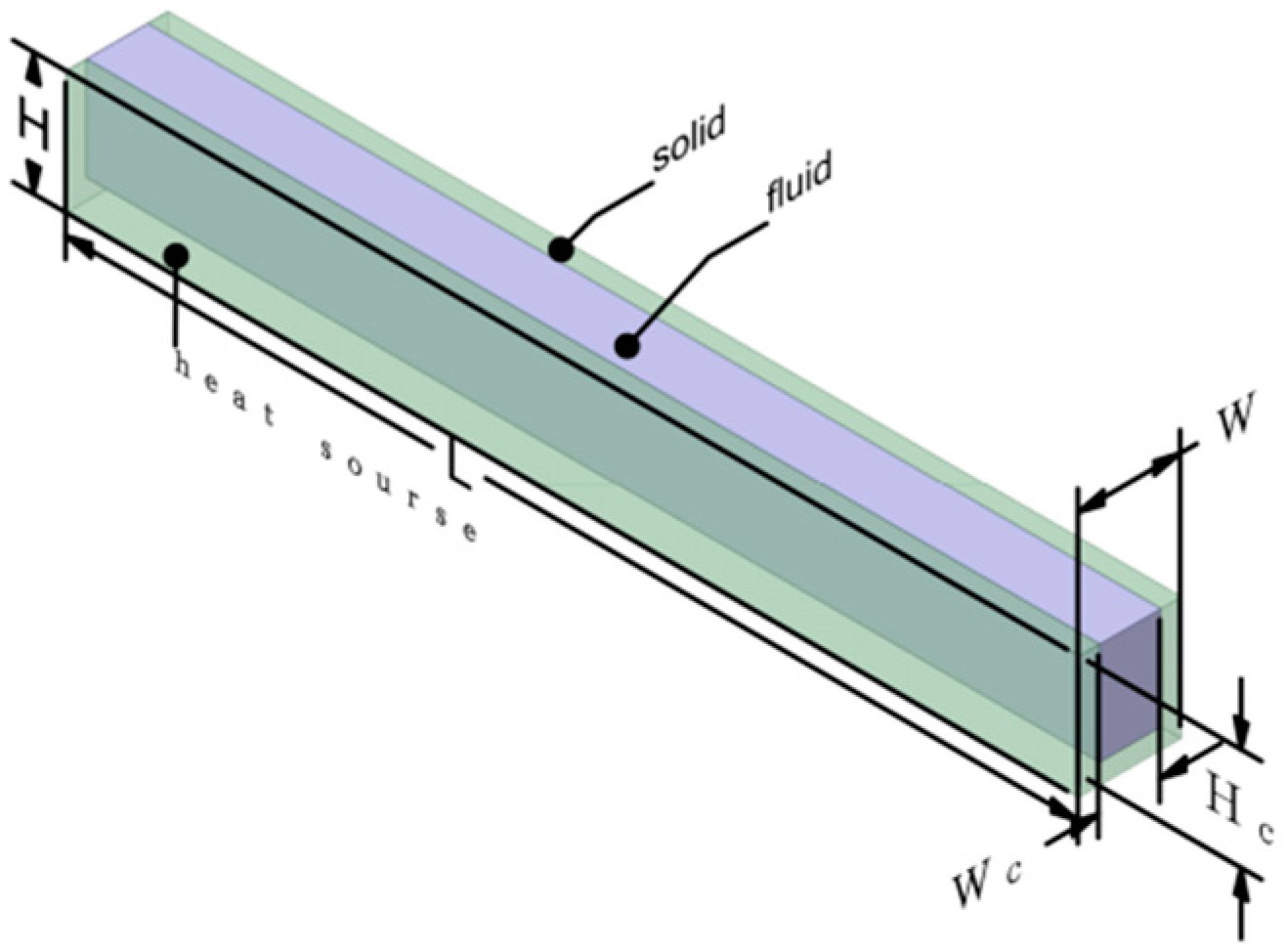

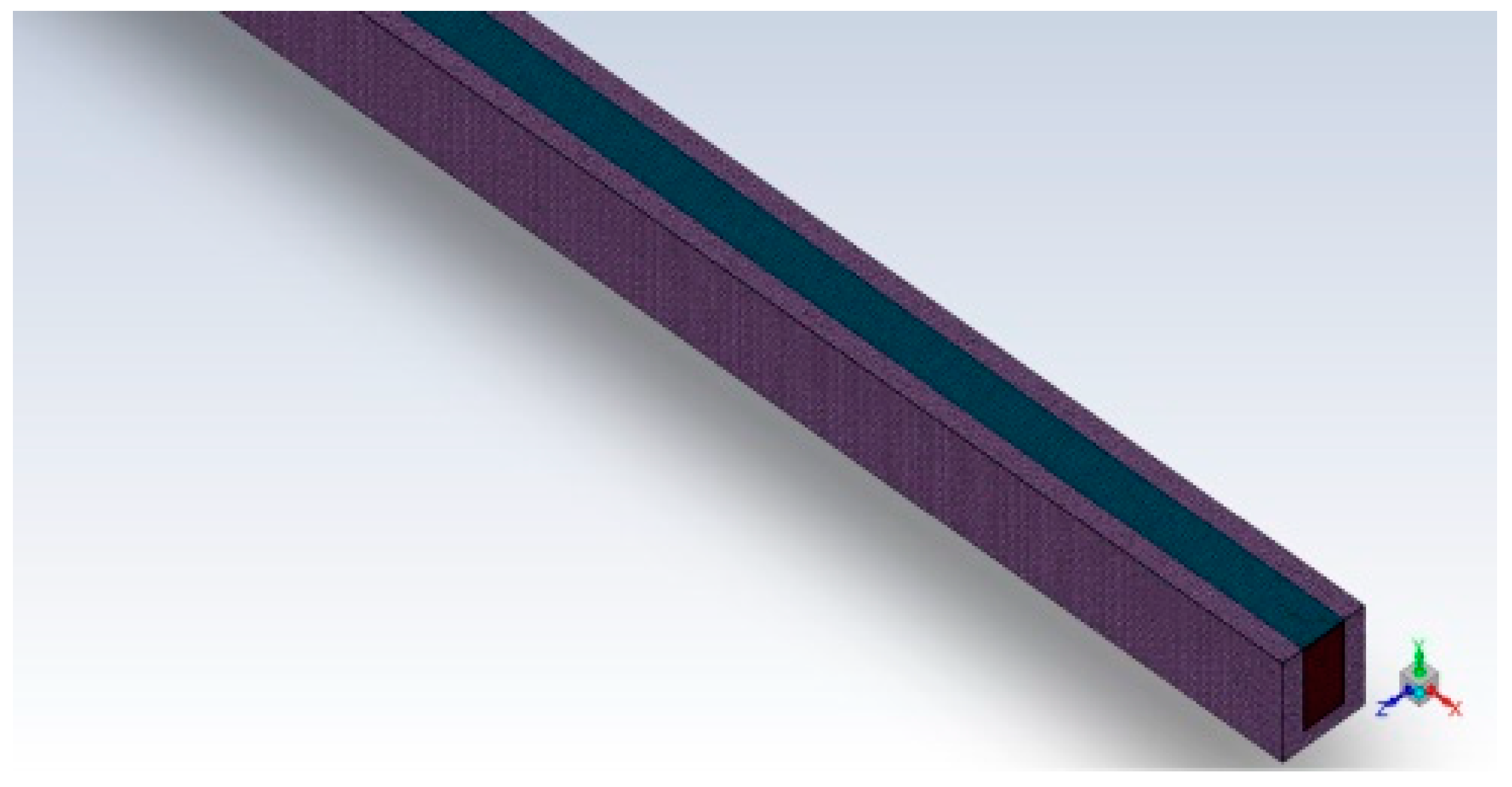
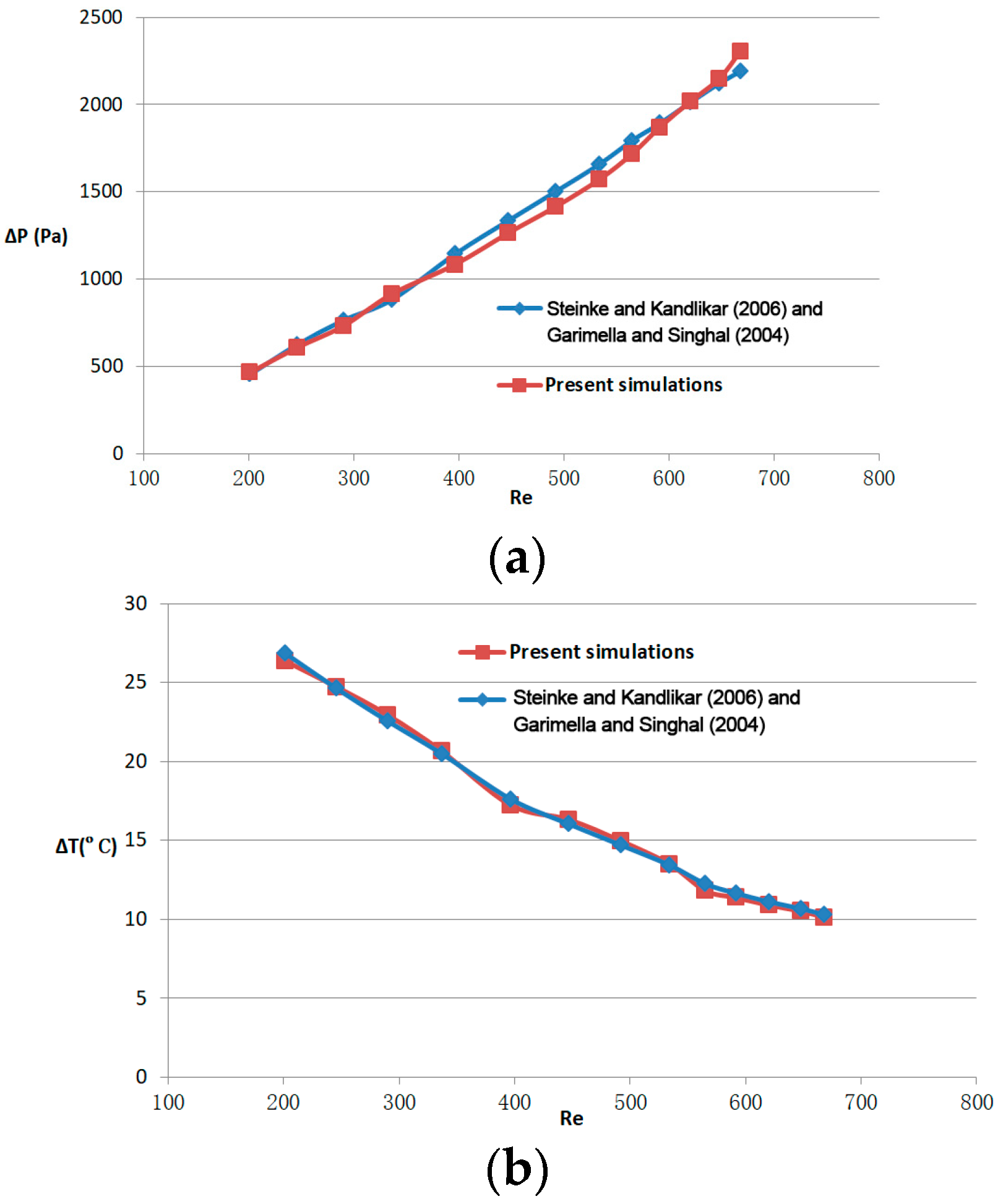
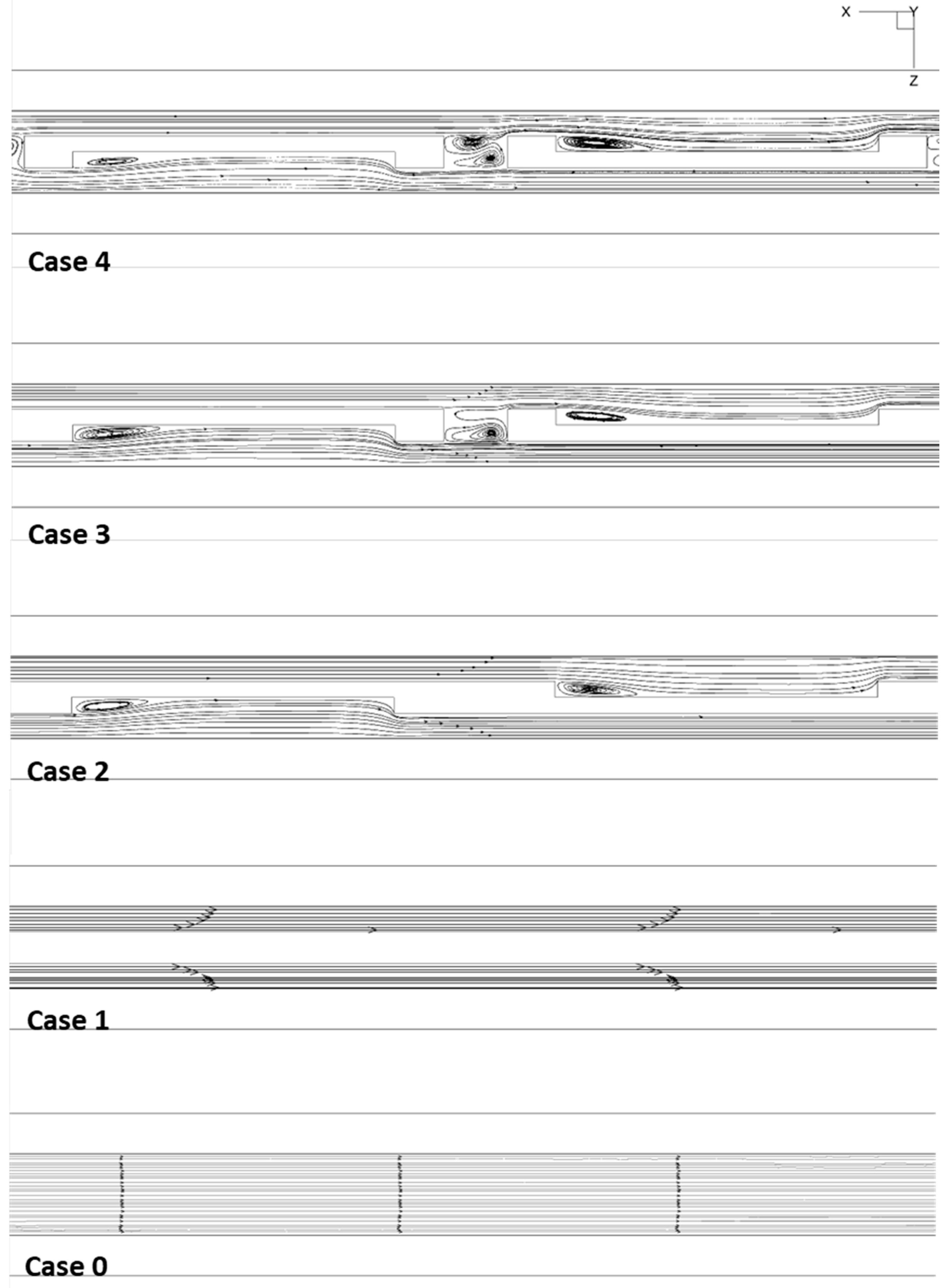
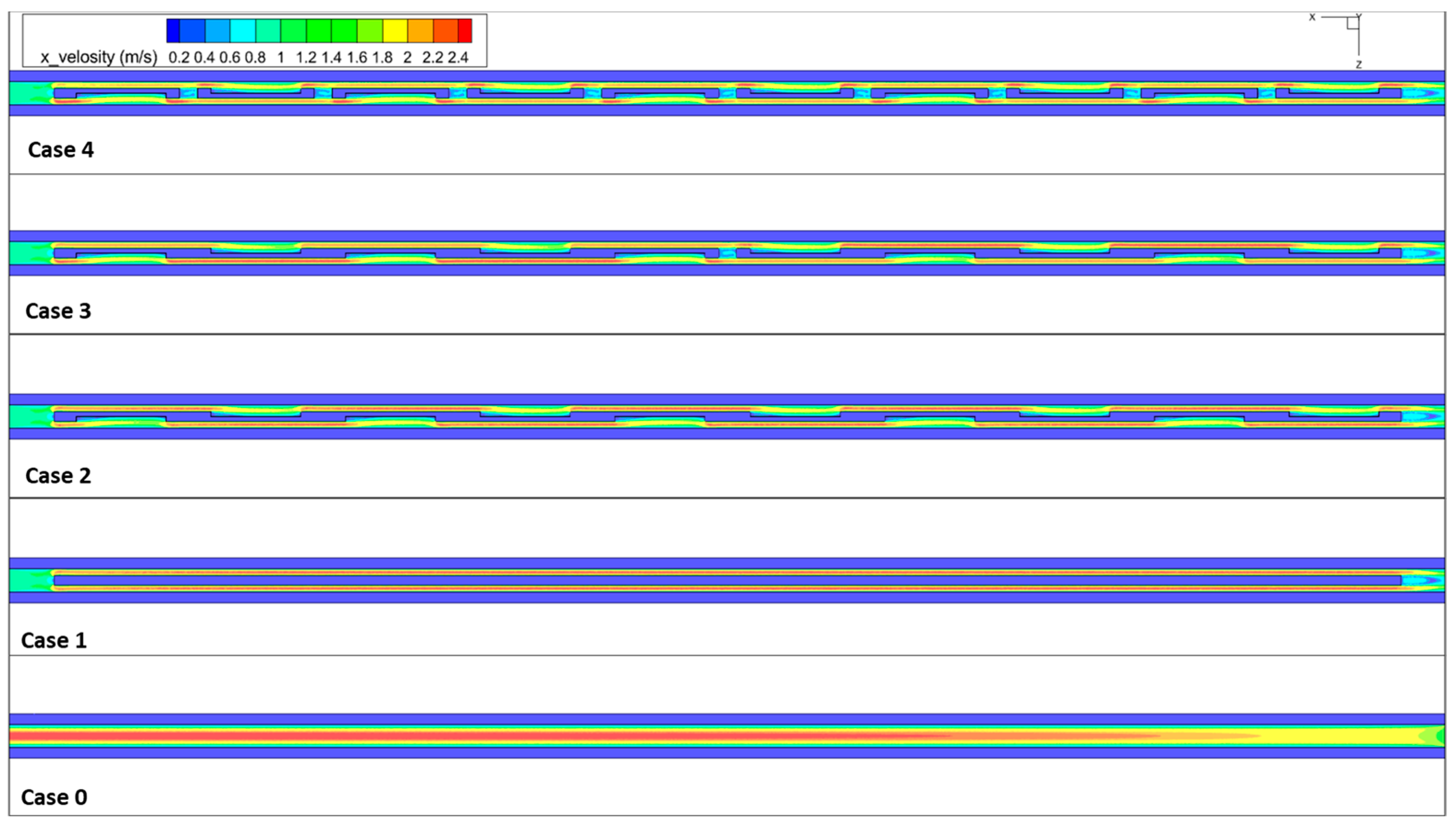
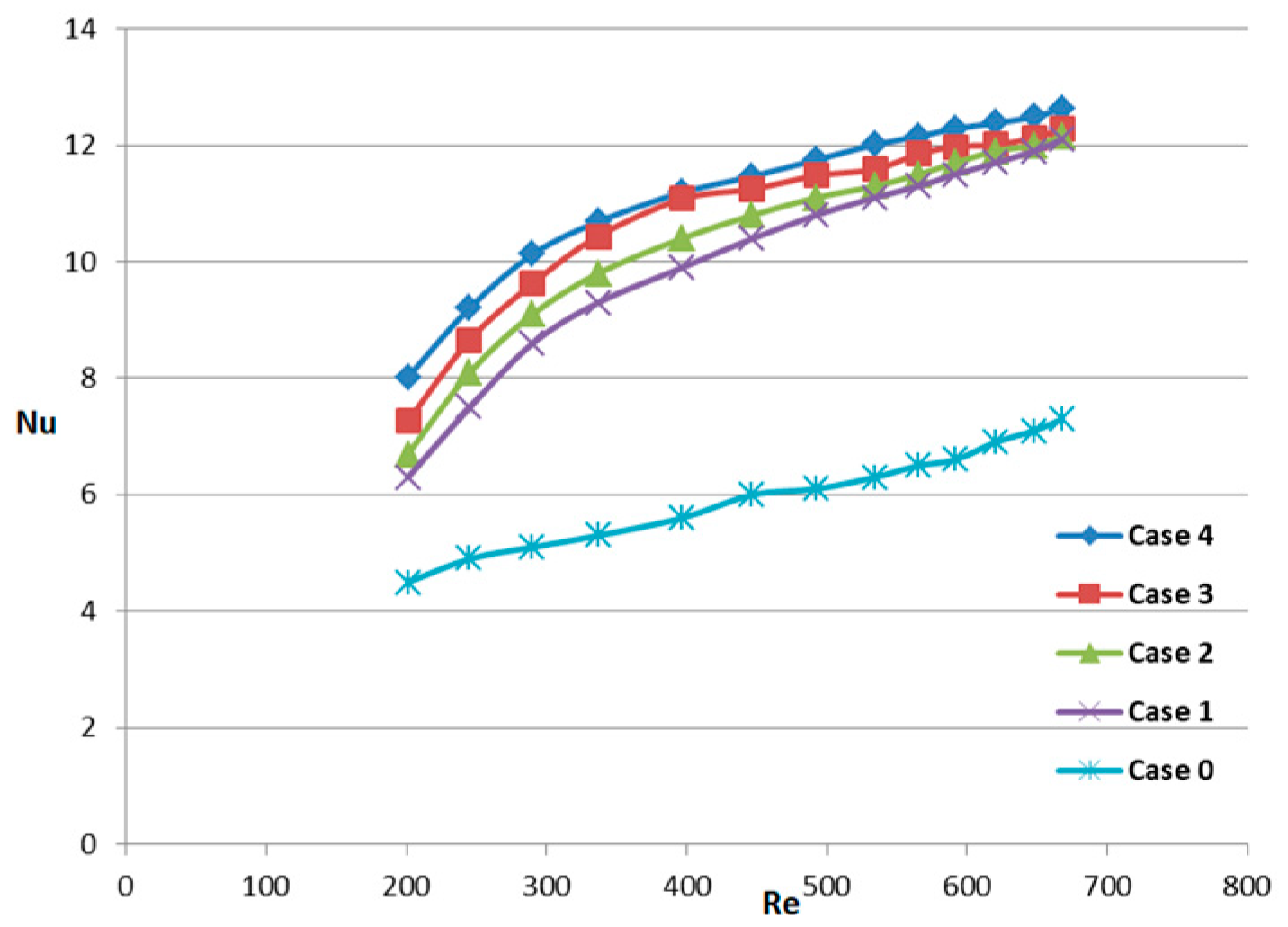
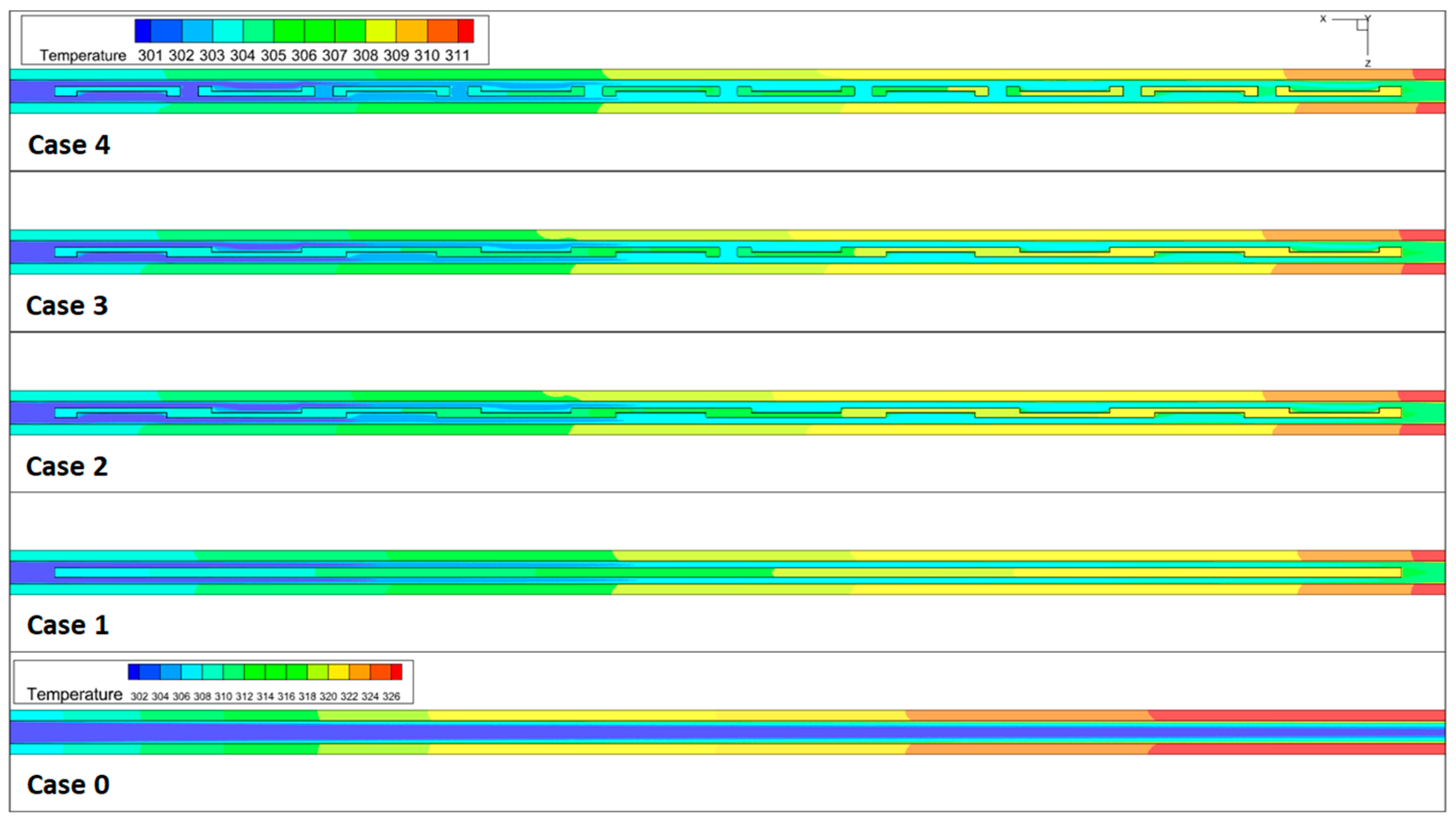
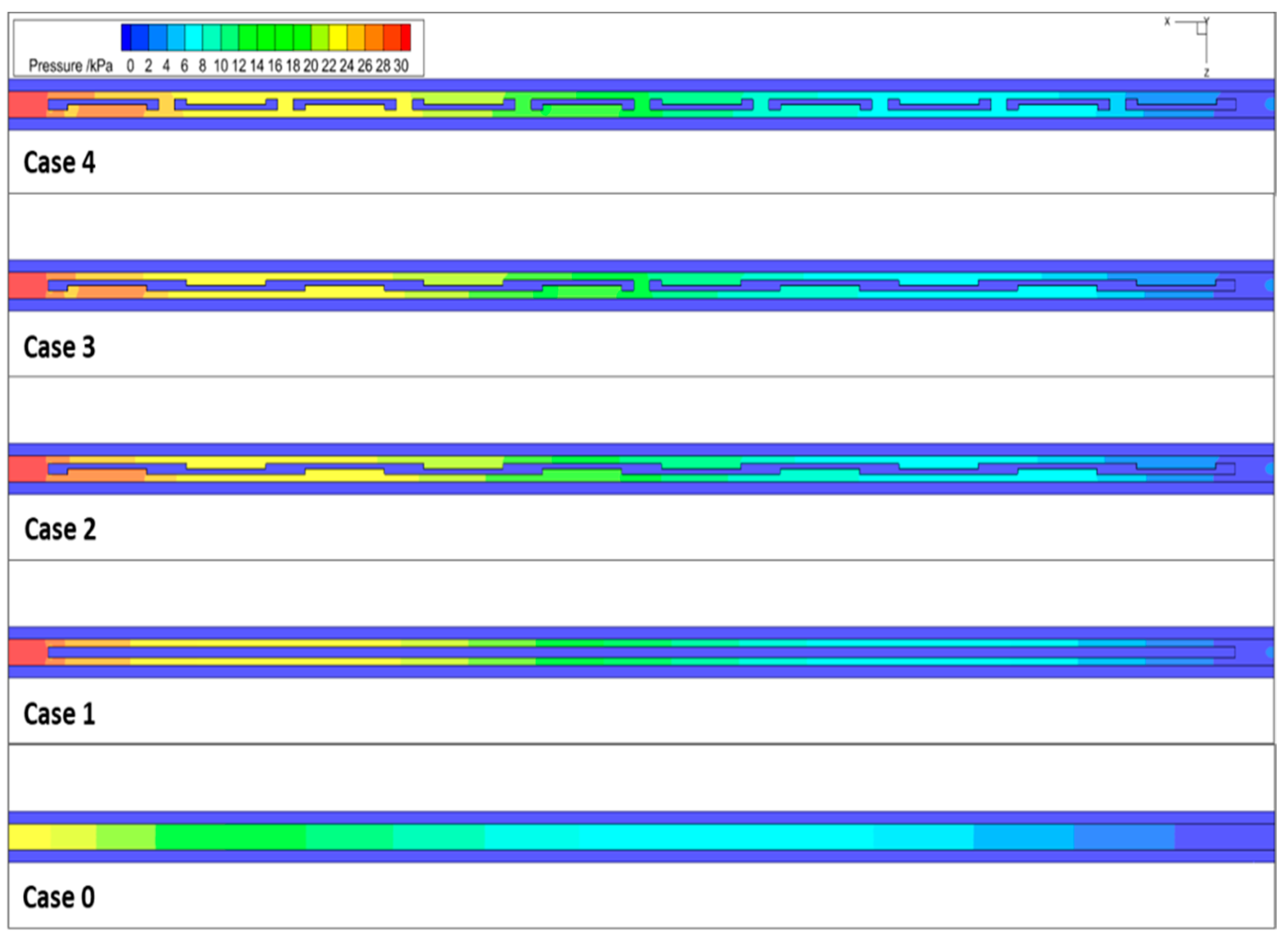
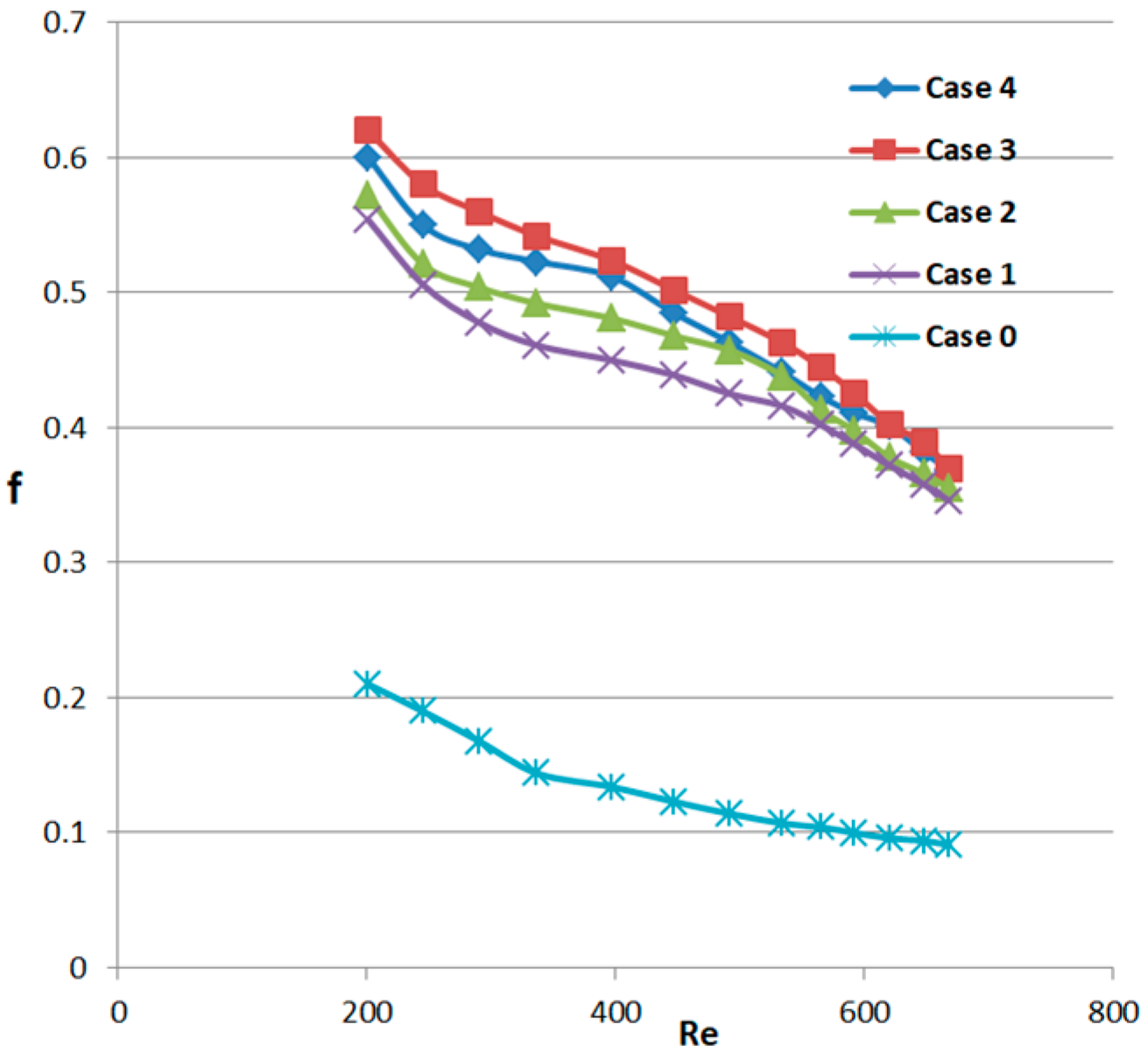

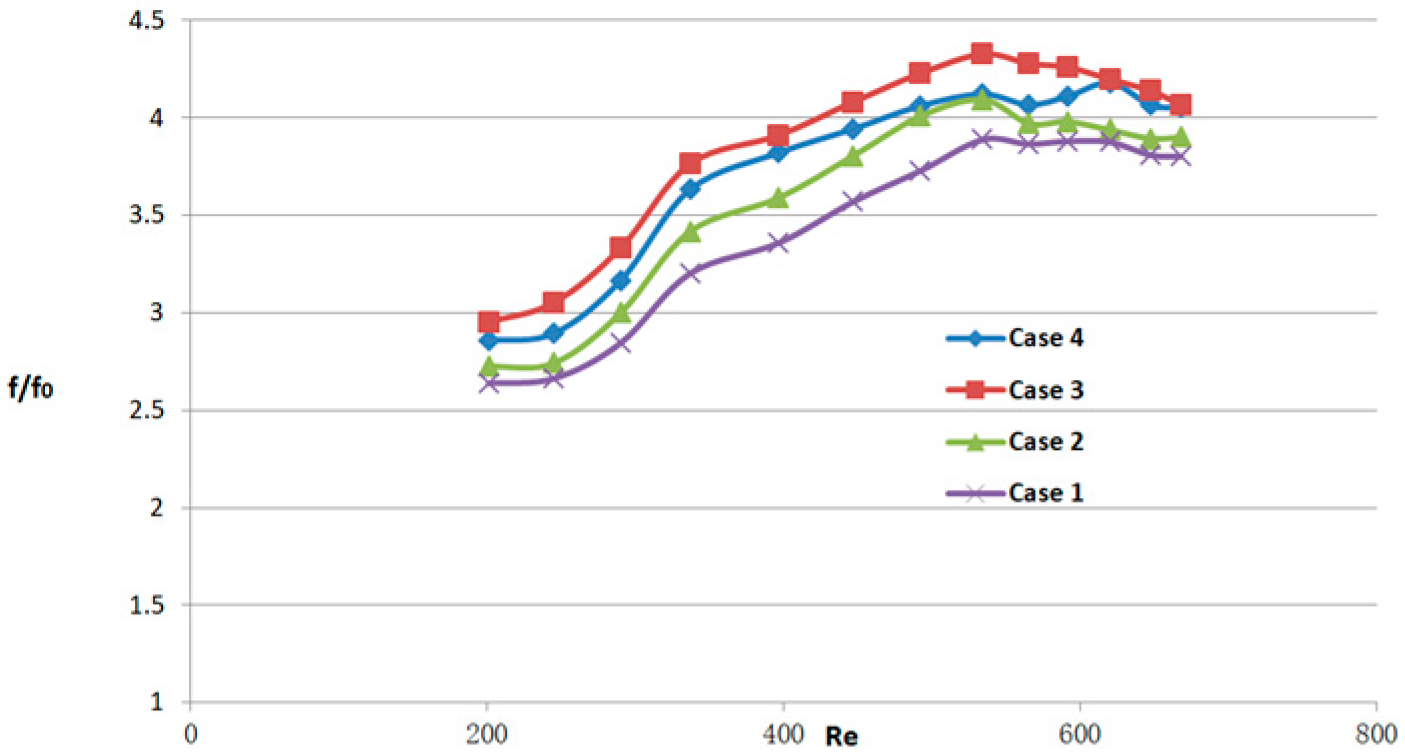
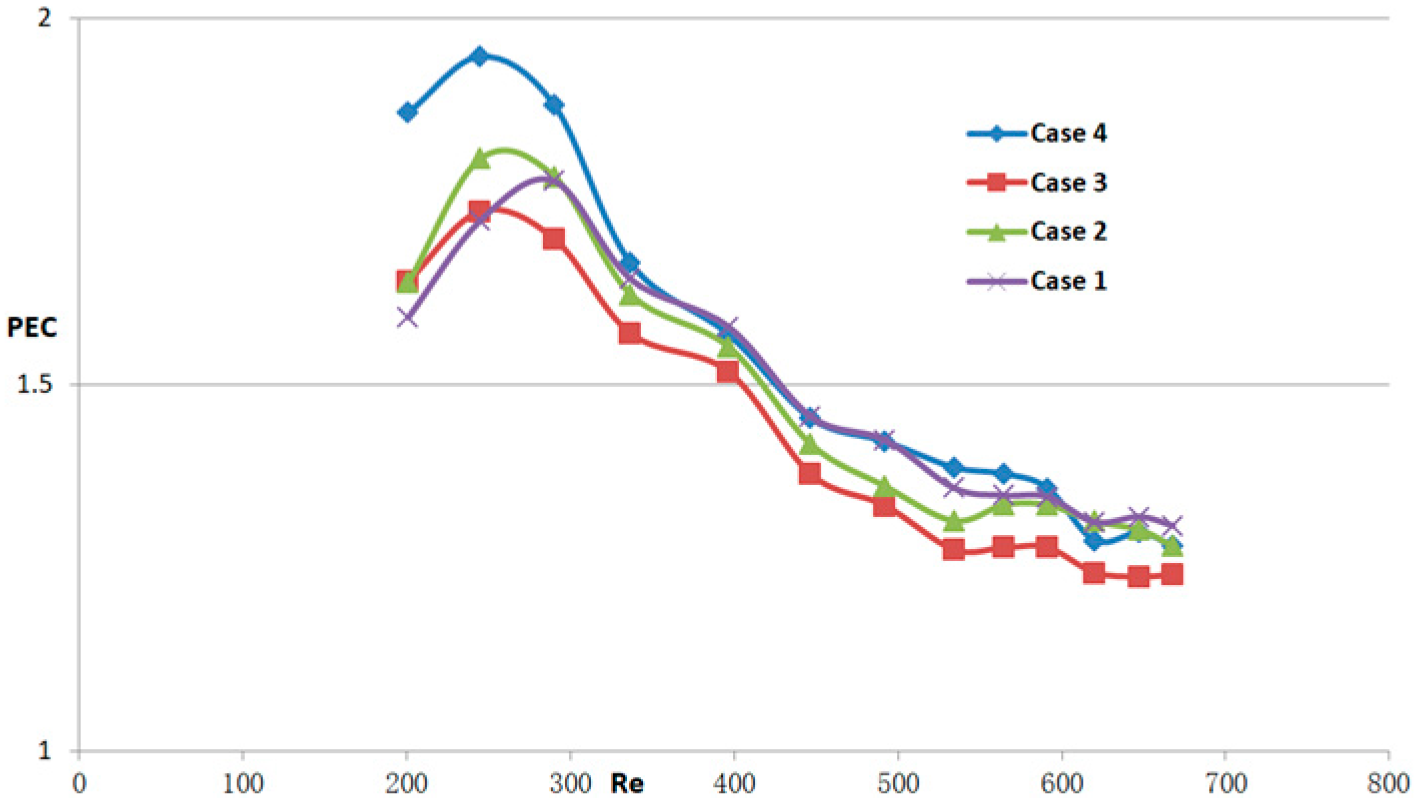
| H | W | L | LB | LB1 | LB2 | LB3 | LB4 | WB | WC | HC |
|---|---|---|---|---|---|---|---|---|---|---|
| 1.2 | 1 | 32 | 5 | 5 | 20 | 35 | 4 | 0.25 | 0.65 | 1 |
| Serial Number | Pressure Drop (Pa) | E |
|---|---|---|
| Mesh 1 (0.379 million grids) | 859 | 1.04 |
| Mesh 2 (0.652 million grids) | 863 | 0.57 |
| Mesh 3 (1.079 million grids) | 866 | 0.23 |
| Mesh 4 (1.479 million grids) | 868 | Baseline |
Disclaimer/Publisher’s Note: The statements, opinions and data contained in all publications are solely those of the individual author(s) and contributor(s) and not of MDPI and/or the editor(s). MDPI and/or the editor(s) disclaim responsibility for any injury to people or property resulting from any ideas, methods, instructions or products referred to in the content. |
© 2023 by the authors. Licensee MDPI, Basel, Switzerland. This article is an open access article distributed under the terms and conditions of the Creative Commons Attribution (CC BY) license (https://creativecommons.org/licenses/by/4.0/).
Share and Cite
Zhao, H.; Ma, H.; Yan, X.; Yu, H.; Xiao, Y.; Xiao, X.; Liu, H. Investigation of Hydrothermal Performance in Micro-Channel Heat Sink with Periodic Rectangular Fins. Micromachines 2023, 14, 1818. https://doi.org/10.3390/mi14101818
Zhao H, Ma H, Yan X, Yu H, Xiao Y, Xiao X, Liu H. Investigation of Hydrothermal Performance in Micro-Channel Heat Sink with Periodic Rectangular Fins. Micromachines. 2023; 14(10):1818. https://doi.org/10.3390/mi14101818
Chicago/Turabian StyleZhao, Heng, Honghua Ma, Xiang Yan, Huaqing Yu, Yongjun Xiao, Xiao Xiao, and Hui Liu. 2023. "Investigation of Hydrothermal Performance in Micro-Channel Heat Sink with Periodic Rectangular Fins" Micromachines 14, no. 10: 1818. https://doi.org/10.3390/mi14101818
APA StyleZhao, H., Ma, H., Yan, X., Yu, H., Xiao, Y., Xiao, X., & Liu, H. (2023). Investigation of Hydrothermal Performance in Micro-Channel Heat Sink with Periodic Rectangular Fins. Micromachines, 14(10), 1818. https://doi.org/10.3390/mi14101818





